Nestled between southeast Asturias, northern Castilla y León and southwest Cantabria, the Picos de Europa is arguably one of the best places in Europe to soak in stunning mountain scenery. Our Headwater Product Development Manager, Sara Hughes, recently went on a condensed trip to the Picos de Europa and is keen to share her experience that will undoubtedly inspire others to visit the “Green Heart of Spain”.
Aside from the beautiful hiking trails, a unique place to stop and refuel is the Cabrales Cheese Exhibition Cave that you can easily book on day three of our Highlights of the Picos de Europa trip. “Now I’m not the biggest fan of blue cheese, but if you are, you need to try Cabrales. It has a strong aroma with an acidic and slightly salty taste. Gamonéu is also pretty spicy and fragrant too. Both pair nicely with fig jam, salami and a sweet glass of sherry”, Sara said.
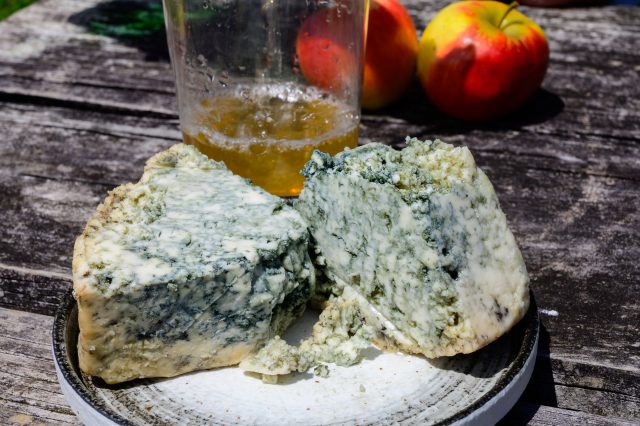
Aged in hundreds of limestone caves scattered across the Cabrales mountains, the high humidity, salt content and cool temperatures provide the perfect conditions inside the caves for the cheeses to ripen. The guided tour tells you about the fascinating history of traditional cheesemaking in the region and how local farmers collect the milk from sheep, cows and goats in the mountains, transport it to the Cabrales caves where it is aged using natural penicillin spores, fungi and bacteria that are present in the stalagmites and tufas. At the end of the tour, you’ll get to taste the local cheese and wash them down with refreshing glasses of Asturian cider.
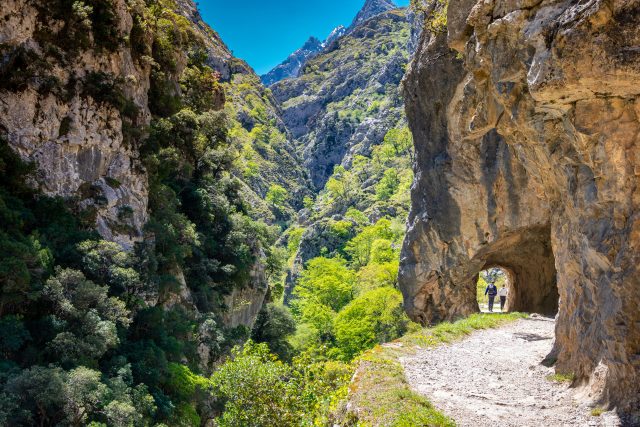
One of the main highlights for many hikers in the Picos de Europa, however, is completing the Cares Trail. Known as the “Divine Gorge”, this hiking trail winds between Caín (León, Castilla y León) and Poncebos (Asturias) and allows you to wander through mountains over 2,000 metres tall, and alongside the imposing river Cares.
On day four of our Highlights of the Picos de Europa trip, you’ll have the opportunity to walk the length of the route for yourself. Stretching a little over 12 km, it’s approximately 25km to do the round trip but you’ll be rewarded with some of the most striking landscapes in the Picos de Europa. “It’s incredible to think that people carved out around 70 tunnels along this route. Back in the 1940s, it was supposedly built to transport food and supplies to the hydroelectric powerplant of Camarmeña – Poncebos, and over the decades that followed they rebuilt and expanded the route for hikers to come and soak in the spectacular scenery.”
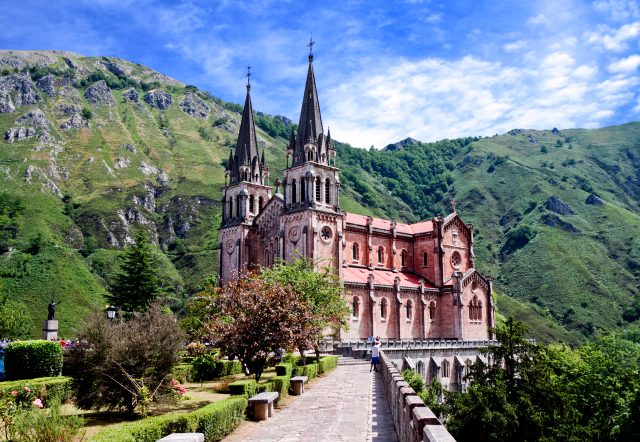
On day six of the Highlights of the Picos de Europa trip, you’ll also have the chance to visit the Basilica of Covadonga. Known as “the spiritual heart of Asturias”, Sara said this Neo-Romanesque church, made entirely of pink limestone, was one of the must-see places on the route. With the main church built by Luis Menéndez-Pidal and Alvarez between 1877-1901, parts of the chapel’s surroundings, like the spectacular Santa Cueva de Nuestra Señora de Covadonga, (the Holy Cave of Our Lady of Covadonga) allegedly date back to Pagan times.
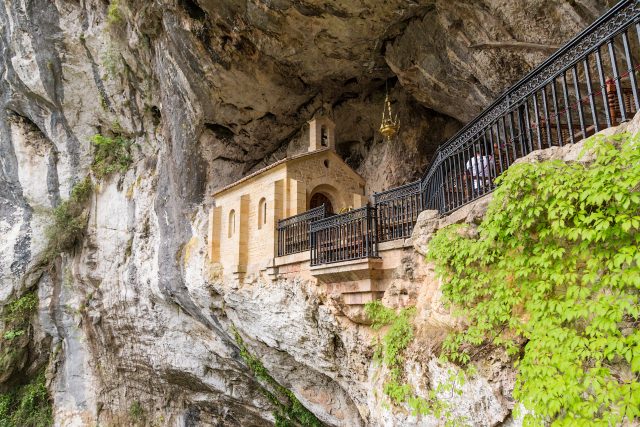
“Today, it’s still a key place of worship and pilgrimage for the people of Asturias and easy to get to on the road back down from the Covadonga Lakes”, Sara explains, “When you walk through the grounds, you can see the statue of King Pelayo in the square while in the cave you’ll find the statue of La Santina and the tombs of King Pelayo and King Alfonso I. As you enter, you’ll see this long corridor that’s all blasted through the rock and lined with red candles. Right at the end near the shrine, we saw a group of nuns sitting there praying, it was a lovely, serene moment.” In the cave itself, you’ll see an opening with natural springs flowing out and a fountain with seven spouts, while on the altar, the golden panel represents the Battle of Covadonga, a clash between Islamic Moors and a force of Christians from Asturias led by King Don Pelayo in 720.
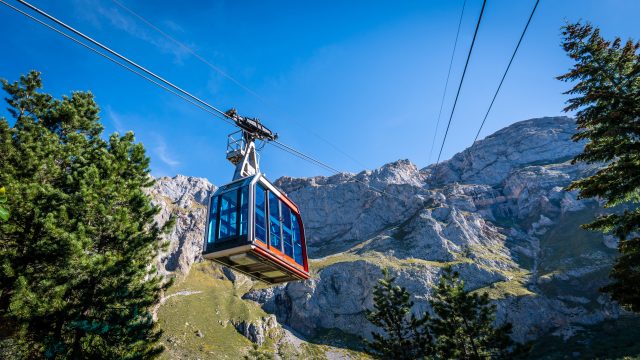
Another unmissable activity Sara recommended was a round trip on the Fuente Dé cable car. “Since the mid-1960s, the Fuente De cable car has been one of the steepest of its kind in Europe, reaching 1,823 metres in under 4 minutes! Even though it’s 17 euros each way, the views on a sunny, clear day would make it well worth the journey.” Covering a 753-metre vertical drop, this exhilarating ride takes you up to the cable viewpoint where you can take in the panoramic view of towering peaks in the Cantabrian Mountains closest to the central massif of the Picos de Europa and the deep Lebaniego valleys. Sara mentioned, “It also offers probably one of the best chances to spot Griffon vultures and Eagles, so remember to bring your binoculars”.
When asked how she would sum up her experience, Sara commented, “What can I say, the Picos de Europa is simply pristine. It’s like a paradise for hikers. And few people know how easy it is to get to. It’s only a two-hour flight to Bilbao and then within an hour and 10 minutes, you’re there. After about 45 minutes you’re surrounded by lush mountains and sweeping gorges. You’re literally going up and up and up, and it’s just beautiful. These mountain regions really take your breath away.” She continued, “You’ll also have the perfect base for the week – the family-run Hotel Torrecerredo. The friendly owners, Jim and Pilar, know the hiking routes like the back of their hand and are only too keen to recommend routes based on your ability. Their restaurant also specialises in local cuisine and delicious homemade desserts – it’s honestly up there with the best hotel food I’ve ever had.”
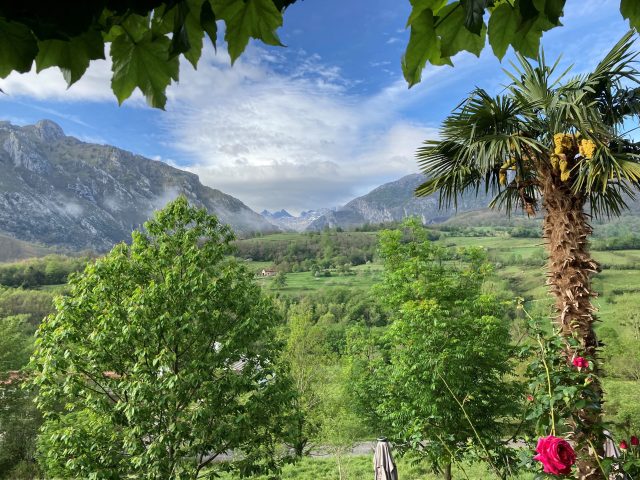
“All the villages you visit are quiet and traditional. The food you’ll dine on is locally produced by farmers and quaint, family-run restaurants too, you’ll find no Starbucks and McDonald’s chains – it’s the perfect oasis away from the city, giving you the opportunity to reconnect with nature, and gain a unique insight into what mountain village life in Spain is like.”
If you’d like to follow in Sara’s footsteps and explore the Picos de Europa for yourself, take a look at our Highlights of the Picos de Europa here.